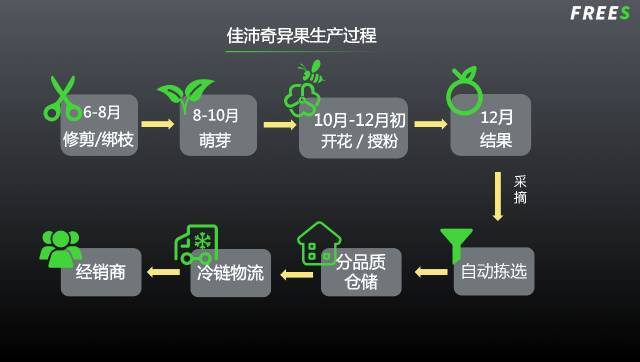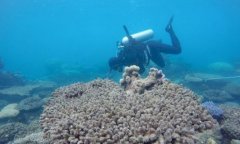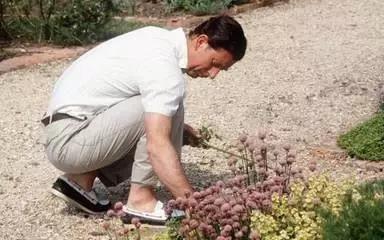Case study: how Jiapei kiwifruit becomes 10 billion products through stable production
If you want to build a fruit brand, large-scale production with stable quality is a necessary prerequisite.
Next, we try to interpret how technological upgrading and organizational change reduce the impact of natural environmental stability on production, leading to the emergence of brands through the case of Zespri ®, a kiwifruit manufacturer in New Zealand.
Jiapei produces an average of more than 3 billion kiwifruit a year and sells it to 53 countries around the world. In 2015, annual sales reached 10 billion yuan, accounting for 33% of the global kiwifruit market. Today, there is no doubt that the company has become the leading global brand of kiwifruit.

Jiapei kiwifruit sales in 2000-2015. Source: Jiapei Annual report
In contrast, the current kiwifruit industry in China lags far behind, which is still dominated by spontaneous planting by fruit farmers and scattered small brands, which has not yet formed a brand advantage.
In fact, when Jiapei was born, the situation of the kiwifruit industry in New Zealand was similar to that in China today. Therefore, we wonder how Jiapei can break through and grow into a fruit giant under the conditions of non-standardization, no brand value and squeezed market in kiwifruit industry.

Organized and large-scale production brings brand formation opportunities for Jiapei.
As early as the 1960-1980s, the number of fruit growers growing kiwifruit in New Zealand has been very large, and the industry has developed rapidly. However, at that time, the industry was still in a state of primitive natural competition, the producers were numerous but scattered, the quality of kiwifruit output was unstable and the output fluctuated greatly, which also led to scattered brands and limited overall influence.
For the above reasons, New Zealand kiwifruit has low bargaining power in the global market. The storm will come soon. In 1988, the United States, its largest overseas market, implemented an anti-dumping policy, which significantly reduced the number of kiwifruit imports, resulting in heavy losses for New Zealand farmers.
The New Zealand government decided to improve the stability of kiwifruit production through organizational change, so as to create a strong kiwifruit brand. "New Zealand kiwi Marketing Bureau (NZKMB)" came into being.
This department, jointly initiated by many fruit growers, is responsible for purchasing kiwifruit from fruit growers and selling them to the market. Other institutions and individuals have no right to interfere with the kiwifruit harvesting and marketing process, and fruit growers are not allowed to sell to the international market privately.
In 1997, the Marketing Bureau decided to launch "Jiapei" as the only brand of kiwifruit in New Zealand, and continue to promote organizational change from the following two dimensions:
First, standardization of production process
"upstream" unified breeding research and development, unified planting standards, unified use of fertilizers and drugs, minimized the interference of uncontrollable factors.
Jiapei mainly promotes two kinds of kiwifruit: Heyward green fruit kiwifruit cultivated by New Zealander Hayward in 1920s and Golden fruit kiwifruit successfully selected in 1991. These two kinds of kiwifruit have the characteristics of stable production.
Hayward has a stable shape, good taste and good storage resistance, while the golden fruit is a mixture of cantaloupe, peach and citrus flavors. It is the most stable variety selected after years of planting and grafting.
At the same time, Jiapei Company uniformly manages the nutrition and pest control drugs needed in the planting process. For example, in 2014-2015, the company provided fruit farmers with drugs against PSA (bacterial canker) to reduce damage.
"downstream" selection, warehousing, logistics standardization, complete control of sales channels.

Jiapei's kiwi fruit production process is standardized.
The picking of kiwifruit in Jiapei is done automatically by the machine. Kiwifruit will be automatically sorted into different warehouses according to quality and size. The quality and size of kiwifruit are basically the same in the same warehouse.
In the warehousing link, in order to reduce the impact of storage time on the quality of kiwifruit, Jiapei uses air-conditioned storage to ensure that kiwifruit does not deteriorate within 8 months; in logistics, cold chain logistics is used to reduce the loss rate to 5%. This is far lower than the transportation loss rate of 10% of Chinese kiwifruit, which is 15% of kiwifruit.
In terms of sales, Jiapei strictly controls the dealer channel. Dealers need to pay a high deposit before they can get Jiapei's supply. At the beginning of each year, dealers also have to pay a fee to Jiapei, of which 30% is spent on farmers' production costs.
Second, establish a virtuous circle of peasant household management system.
"Supervision mechanism" farmers are highly controllable
Jiapei uses the following three ways to monitor the production of farmers, so as to make the supply chain controllable:
Traceability mechanism. Unified management of fruit growers with production tracking traceability information card. When there is a quality problem with a batch of fruit, Jiapei can quickly locate the origin of the batch and the responsible fruit grower.
Geographically intensive regulation. 80% of kiwifruit is produced in Fengsheng Bay, New Zealand. The production area covers an area of 12000 square kilometers, which is the size of Tianjin. Centralized production can significantly reduce regulatory costs. In addition to Jiapei, Wen's (see "Fengrui report 11: trillions of pigs really stood in the tuyere on the eve of the outbreak of the pig industry"), American strawberry brand Doriscoll and others have also adopted the same approach.
Purchase according to the standard price. Fruit growers forbid the use of any compounds three months before picking the fruit. Subsequently, Jiapei will entrust a third-party testing agency to enter the orchard for sampling. When the sweetness, maturity and dry matter content of the fruit reach the standard, it can be picked by hand. Finally, professional testers will screen the fruits according to their appearance, and only high-quality fruits are allowed to be labeled Jiapei.
"incentive mechanism" moderately motivates farmers
Jiapei Company uses the following three ways to establish a benign incentive mechanism for farmers, so as to further stabilize the supply chain:
30% deposit in advance, guaranteed acquisition. Before entrusting fruit growers to plant, Jiapei will pay 30% deposit to fruit growers in advance, and the remaining 70% will be used as profit income, which will be determined by market sales conditions. If the fruit provided by the fruit grower is of high quality, you can get a bonus from the company. At the same time, Jiapei will also take measures such as guaranteed acquisitions and equity dividends.
Brand building brings higher bargaining power, and the income of fruit growers increases accordingly. In 2001, Jiapei kiwifruit sold at US $5.22 per box in the Asian market, rising to US $6.42 per box in 2003. So far, the price per box has exceeded US $10. Through the construction of the brand, Jiapei's influence in the market is constantly enlarged, the fruit quality is excellent, the price rises accordingly, the income of fruit growers increases accordingly, and the enthusiasm of production is constantly stimulated.
Control the size of single fruit growers to ensure that the fruits can be carefully taken care of. Jiapei manages more than 2700 fruit growers, with a total planting area of about 10580 hectares. Among them, 2-5 hectares of orchards account for 45%, 5-10 hectares of orchards account for 15%, small-scale fruit farmers are the main production force.
Many aspects of kiwifruit planting can not be mechanized, such as the need to remove underdeveloped young fruit, regular pruning of excess bifurcations and so on. If the scale of a single fruit farmer is too large, the management will inevitably be extensive; if the scale is too small, the income will inevitably be low.

Controlling the size of individual fruit farmers can make kiwifruit more carefully taken care of.
It is estimated that 3.33 hectares (about 50 mu) is an area that can be taken good care of by a single fruit farmer. On this scale, the average annual net income of a single farmer is about S $30,000 (assuming a net interest rate of 10 per cent 15 per cent), or 150000 yuan.
In short, through continuous technological upgrading and organizational change, Jiapei has established a high-quality and high-output kiwifruit supply chain, which has become a moat of its brand value.
- Prev

The Great Barrier Reef is increasingly eroded Australia spends more than 300 million yuan on insurance
The Great Barrier Reef is the largest and longest coral reef in the world and is an ideal diving destination for many diving enthusiasts. However, it is a pity that with the increasing global warming, the temperature of the sea water is also gradually rising, and the World Heritage Great Barrier Reef has become more and more popular in recent years.
- Next

Prince Charles failed to start a business, saying that the entrepreneurial environment of the rotten country is too bad.
A long time ago, about 30 years before China proposed mass entrepreneurship and innovation, Prince Charles started his own business. He set up an eco-agricultural project. In 1986, Prince Charles bought a void full of devastation, ruins and abandoned churches.
Related
- A one-day flower show brings 130 million yuan in orders! Nanhai, this Phalaenopsis exhibition is amazing
- What do the flower language and meaning of Lutheran tree mean? Precautions for planting Lutheran tree
- Encounter Chaoshan Kongfu tea, not without this cup of Phoenix single clump
- The durian market in Vietnam and Thailand is flooded. The price of imported durian has plummeted by 30-40% in a month.
- Shanghai solved the problem of local vegetable supply by planting 80,000 mu of green leafy vegetables.
- Wageningen University has become the best agricultural university in the world for the seventh time in a row.
- The strongest export season of South African grapes is full of challenges, with exports to Russia falling sharply by 21%.
- Sri Lanka is on the verge of bankruptcy, "Tea for debt" Organic Agriculture Revolution aggravates the Food crisis?
- Turning waste into earthworm manure and worm manure into organic fertilizer-A new choice for auxiliary farming
- Organic rice growers shoulder the responsibility of nurturing agricultural talents! Yinchuan Sustainable Farm with Organic Life Camp

